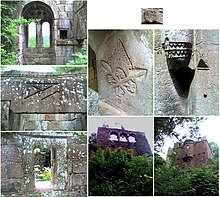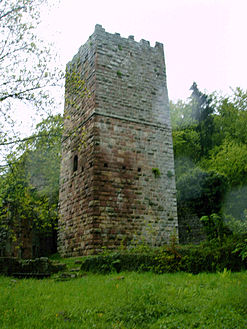Wildenberg Castle (Kirchzell)
| Wildenberg Castle | ||
|---|---|---|
|
Wildenberg Castle - gate tower |
||
| Alternative name (s): | Wildenburg | |
| Creation time : | around 1200 | |
| Castle type : | Höhenburg, spur location | |
| Conservation status: | ruin | |
| Place: | Kirchzell -Preunschen | |
| Geographical location | 49 ° 35 '46.7 " N , 9 ° 11' 43.4" E | |
| Height: | 365.2 m above sea level NN | |
|
|
||
Burg Wildenberg , even Wildburg called, is a Stauffer period castle ruins in the Odenwald and belongs to the village Preunschen , part of Kirchzell , in the Lower Franconian district of Miltenberg in Bavaria .
Geographical location
The ruin of the hilltop castle is located on a mountain spur of the castle hill that is pushed to the northeast at 365.2 m above sea level. NN above the valley of the Mud , three kilometers southeast of Kirchzell only a few hundred meters northeast of the center of Preunschen, about 13 kilometers southwest of the district town of Miltenberg .
history
The Lords of Dürn , deserving followers of the Staufer emperors and protection guardians of the Amorbach monastery , are considered to be the builders of the castle , the construction of which is dated between 1180 and 1200. According to the Amorbach monastery chronicle, however, it was not until his grandson Konrad I von Dürn (died 1258) that construction began around 1216. Probably only the construction of the gate tower is meant.
In the years 1271 and 1272 the castle was partly sold to the Archbishopric of Mainz after financial difficulties of the Dürner family and later became the official seat of the Mainz administration after the rule of Walldürn was completely acquired by Mainz in 1292. The administration was initially carried out by officers , later by Vogt or Burggraf . In 1291 Heinrich was officiate, around 1320 it was Konrad Rüdt von Collenberg . In 1337 Archbishop Heinrich was reconciled with his cathedral chapter and handed over Wildenberg Castle to the canons for a short time. In 1350 the office of the castle was pledged to Eberhard von Rosenberg , in 1354 Konrad Rüdt von Collenberg redeemed the pledge. By increasing his loans to the Archbishopric of Mainz, Konrad also received the offices of Walldürn and Buchen. In 1356 an earthquake is said to have severely damaged the castle. Archbishop Gerlach pledged Wildenburg Castle, the city of Amorbach and a Gülte in Miltenberg to Engelhard von Hirschhorn in January of the same year, without the consent of his cathedral chapter . A year later he borrowed money from his Burgrave in Wildenburg, Konrad Rüdt von Collenberg.
From 1368 Wiprecht von Dürn, Eberhardt Rüdt von Bödigheim, Fritz von Dürn and Eberhard von Fechenbach were Mainz castle men. In the period that followed, up to the 15th century, representatives of these families were mostly mentioned as officials.
Between 1400 and 1511 the castle was expanded in the late Middle Ages . The west tower and the barrier wall through the courtyard were built, the chapel was renewed. The castle was the seat of a Mainz bailiff of the Amorbach office until 1525. During the Peasants' War it was peasants from the " Hellen Haufen " of the knight Götz von Berlichingen who burned down Wildenberg Castle on May 4, 1525. It has been in ruins ever since.
In 1803 it came briefly to the Principality of Leiningen as a result of secularization . In 1806 the Principality of Leiningen was mediatized by the Grand Duchy of Baden . As early as 1810, the castle with the area around Amorbach became part of the Grand Duchy of Hesse-Darmstadt and in 1816 came to the Kingdom of Bavaria through an exchange of territory .
Today the castle ruins are a popular hiking destination and are occasionally used for cultural events.
description
In essence, the roughly rectangular, approx. 80 meter long central castle from the Hohenstaufen era, which was later hardly changed, has been preserved. A diagonally set donjon stands against the mountain side . On the south side there is a gate tower with a stepped portal and a chapel with an apse bay on the upper floor. The spacious Palas is based on the valley side. The window arcades on the upper floor are of great artistic value and are comparable to those in the imperial palace of Gelnhausen and Girbaden Castle in Alsace.
A partition wall in the middle of the castle courtyard should be noted as a post-Hohenstaufen addition. In addition, there was hardly any structural change, which is why Wildenberg can be regarded as one of the best preserved Hohenstaufen castles in southern Germany despite its ruinous condition.
The castle is rich in various stonemason's marks (at least 50 different are proven), some of which can also be found in other castles in the Rhine-Main-Neckar region, e.g. B. Stolzeneck Castle on the Neckar (and also in the Kaiserpfalz Gelnhausen ).
In front of the castle at the beginning of the spur ridge south-west towards Preunschen and several meters above the castle is the rock (en) castle , a cave carved into a naturally exposed rock formation with a rectangular stone entrance portal. The rock was worked on and slabs of rock were arranged so that a flat platform was created above. That this as a kind of outer bailey was created to protect the spur side, it can be assumed, but not proven.
Parts of the castle were used in the 19th century to build the artificial ruins of Eulbacher Park .
Record of Parzival
Due to personal insertions made by Wolfram von Eschenbach in his verse novel Parzival , it is assumed in research that after the Count of Wertheim was mentioned in the 4th book, the author wrote the beginning of the epic at Wertheim Castle and at a “Wildenberg Castle "Continued: In the 5th book, Wolfram, in his description of the Grail Castle Munsalvaesch, compares the fires in the royal hall there with the more modest fires in his host's castle:" Who ever saw such big fires / Here with us in Wildenberg? "Thus, it is assumed that Wolfram von Eschenbach wrote part of the novel in a castle in Wildenberg.
Misunderstandings arose because Munsalvaesch or Montsalvaesch can also be directly interpreted as Heilsberg or wild mountain (cf. section 230, verse 13) and thus there was speculation about a "Burg Wildenberg" as the Grail Castle. However, this brought further castles of the same name into the discussion, but Wolfram von Eschenbach may have drawn his description of the holy mountain only from contemporary paradise literature. In no case, however, can the above-mentioned line of text be interpreted as indicating an identity with the Grail Castle. The castle Wildberg (Kirchzell) is considered likely place of writing the fifth book or from this book.
- Wildenberg Castle
annotation
- ↑ It is known that Wolfram von Eschenbach probably wrote part of the Parzival at the castle , which, as is generally assumed, was written between 1200 and 1210. Assuming that the early date of construction should apply.
literature
- Alexander Antonow: Castles in the Main Square. Breuberg, Freudenberg, Miltenberg, Prozelten, Rothenfels, Wertheim, Wildenberg (= handbook series historical buildings. Volume 1). Antonow, Frankfurt am Main 1987, ISBN 3-924086-30-3 , pp. 111-126.
- Thomas Biller: Castles and palaces in the Odenwald. A guide to history and architecture . 1st edition. Schnell und Steiner publishing house, Regensburg 2005, ISBN 3-7954-1711-2 , pp. 151–157.
- Günther Ebersold: Wildenberg and Munsalvaesche. On the trail of a symbol . Peter Lang Verlag, 1988, ISBN 3-631-40393-3 , therein esp. Pp. 64-83.
- Manfred Hofmann, Klemens Scheuermann, Clemens Speth: Wildenberg Castle. Adelsburg - official seat - ruin . Waldkirch Verlag, Mannheim 2015, ISBN 978-3-86476-058-7 .
- Walter Hotz : Wildenberg. Origin and shape of a Hohenstaufen castle . Verlag Hermann Emig, Amorbach 1979.
- Walter Hotz: Castles of the Hohenstaufen period in the Odenwald area. In: Winfried Wackerfuß (Ed.): Contributions to the exploration of the Odenwald and its peripheral landscapes II. Festschrift for Hans H. Weber. Breuberg-Bund , Breuberg-Neustadt 1977, pp. 155–168, especially p. 158 and 162.
- Hans Kunis: Wildenberg. The Grail Castle in the Odenwald. Published by M. Schäfer, Leipzig approx. 1935.
- Tilman Mittelstrass: The knights and servants of Hettingen, Hainstadt, Buchen and Dürn (= Between Neckar and Main . Issue 26). Buchen District Museum Association, 1991.
- Ursula Pfistermeister : Defensive Franconia. Volume 2: Castles, fortified churches, city walls around Würzburg . Hans Carl Verlag, Nuremberg 2001, ISBN 3-418-00386-9 , pp. 97-99.
- Thomas Steinmetz: Castles in the Odenwald . Brensbach 1998, ISBN 3-931529-02-9 .
Web links
- Kirchzell - Burg Wildenberg 360 ° several 360 ° panoramas on the website of " Burglandschaft Main4Eck " burglandschaft.de
- Wildenberg castle ruins on the House of Bavarian History site
- Wildenberg Castle - An introduction (PDF file; 350 kB)
- "The secret of the Wildenburg" - an online adventure game in which the castle is the focus
Individual evidence
- ^ Fritz Vigener (arr.): Regest of the Archbishops of Mainz from 1289-1396. / Second section (1354-1396) , first volume 1354-1371. Reprint of the edition Leipzig 1913, Berlin 1970 ,. Regest 500 & 910.
- ^ Wolfram von Eschenbach , Parzival, selection , Reclam edition, 5th book. In the original: "ŝo grôziu fiwer sît noch ê / sach niemen hie ze wildenberc:" in: Wolfram von Eschenbach: Parzival , study edition after Karl Lachmann , Verlag Walter de Gruyter , Berlin 1965, p. 104, 280,12 / 13. (Unchanged: Leipzig 1926).
- ↑ Günther Ebersold: Wildberg and Munsalvaesche , Peter Lang Verlag, Frankfurt, Bern, New York, Paris, 1988, ISBN 978-3-631-40393-8 . 139 pages; Table of contents here














